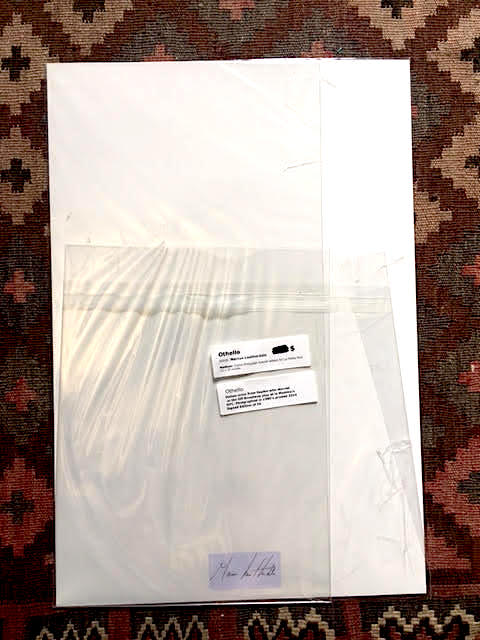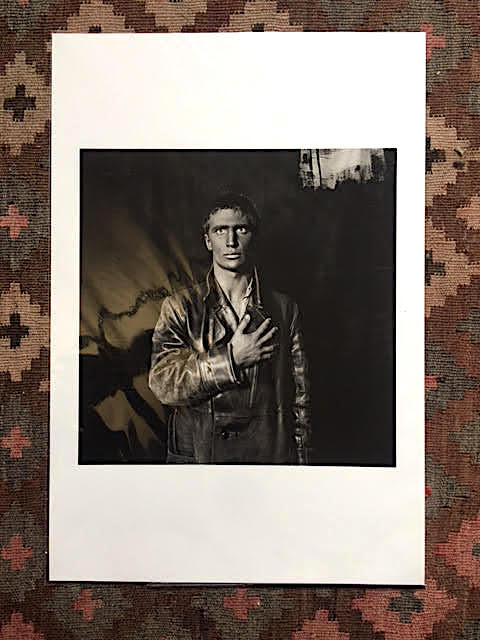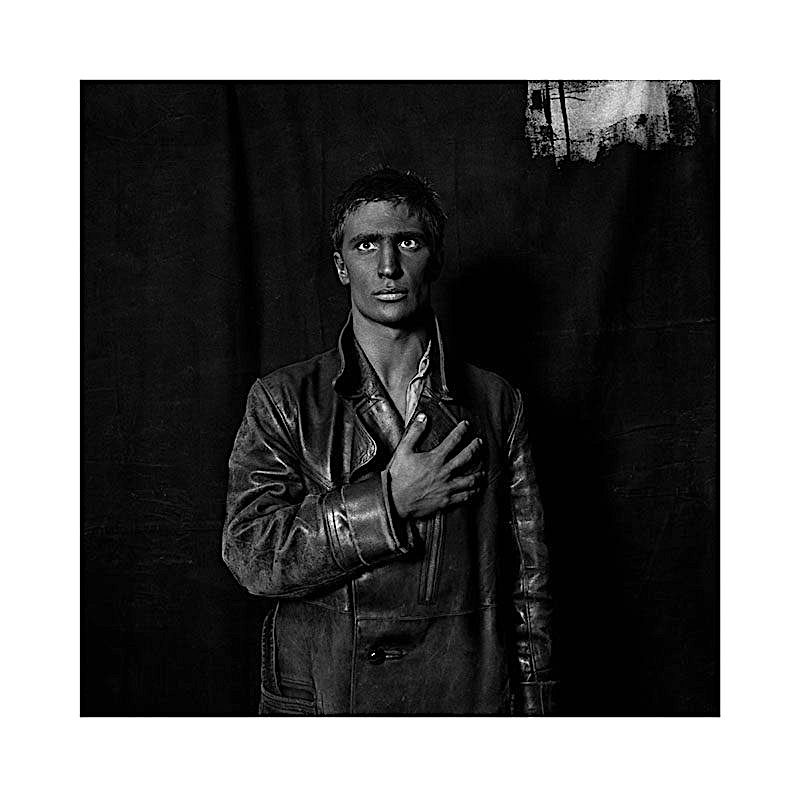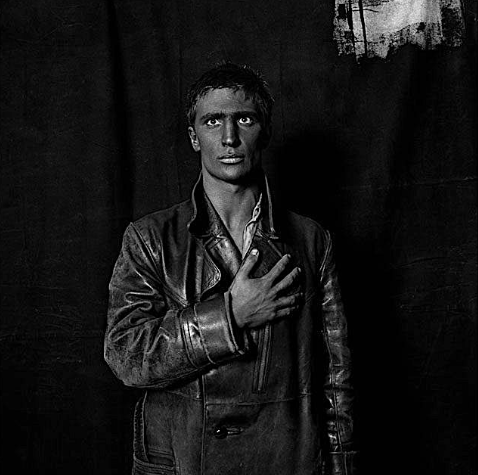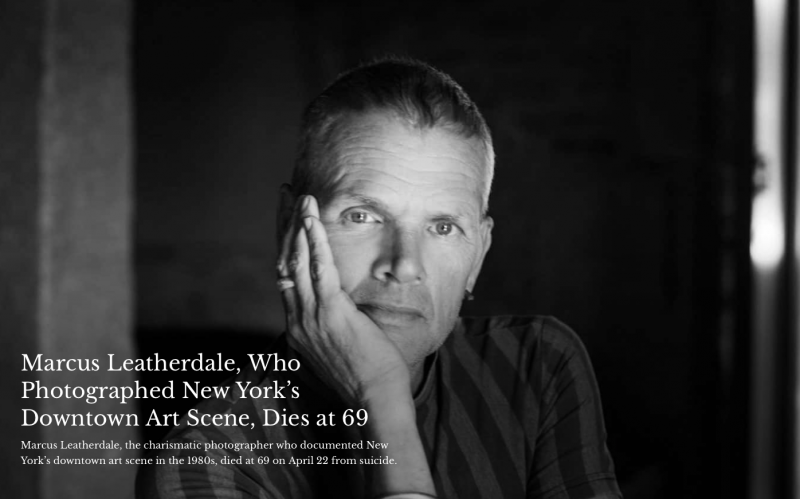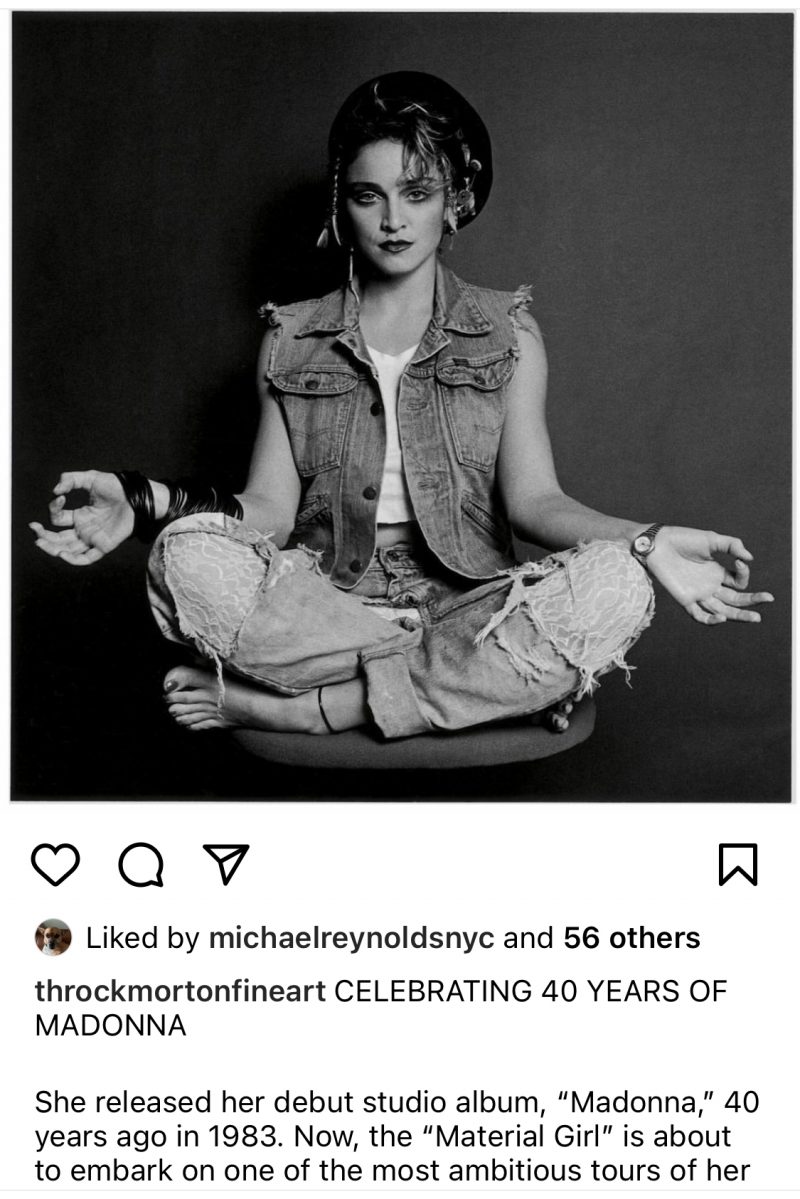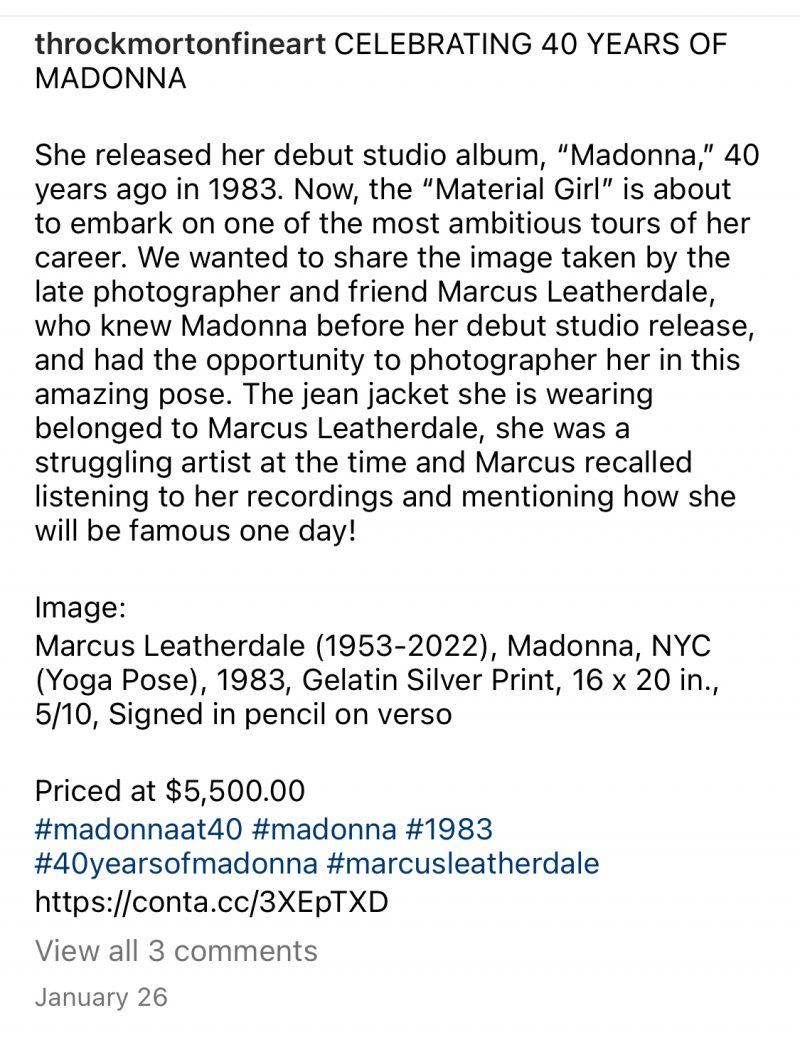SOLD. Marcus Leatherdale (New York, USA), ‘Othello’ Signed Photograph 1980’s
Marcus Leatherdale, New York, USA, (18 September 1952 – 22 April 2022)
‘Othello’, Digital Photograph, Special Limited Edition of 50, for La Petite Mort Gallery, Print measures 13 x 19 inches, Print image measures 11 x 11 inches. Mint Condition.
‘Othello’, Actor from Naples who starred in the Off Broadway play at La Mamma’s, NYC.
Special Limited Edition for La Petite Mort Gallery. Printed on Archival Epson Matte Paper. Mint Condition.
Edition 1/50
Photographed in the 1980’s, Printed Between 2014 & 2022. Signed on label / verso of print, with letter of confirmation by the artist. The prints were made in a professional lab in Canada, by permission of Marcus Leatherdale, and signatures were hand written by the artist on archival labels, and shipped from Portugal, where the artist resided at the time ( see return address & signature on envelope).
Any further inquiries, please feel free to ask.
Appraised at USD$2500 / Please see Madonna image attached above, selling in NYC for USD$5500.
SOLD to raise funds for the “Feed 100 People in Need Project” done annually at Christmas in a small fishing village called Boca de Tomatlan, Mexico.
See more info here: https://guyberube.com/37178-2/
Special Limited Edition for La Petite Mort Gallery, Ottawa, Canada by permission & collaboration with Marcus Leatherdale.
Montreal-born photographer Marcus Leatherdale (1952) has been exhibiting for more than 30 years in galleries worldwide. His work has been published in such magazines as The New Yorker, Vanity Fair, Details, and Elle Decor, featured in publications from Artforum to Interview, and is in the permanent collections as museums such as the Art Institute of Chicago and Austria’s Vienna Museum of Modern Art.
First known for his arresting portraits of New York City celebrities (Hidden Identities series-Details) in the 1980s, in 1993 Leatherdale began spending half of each year in the Indian holy city of Banaras. Based in a 200-year-old house in the old city, he began photographing the diverse and remarkable people there, from the sadhus (holy men) to celebrities, royalty to the Adivasi (tribals). Each year, for the six months he lives in India, he works out of his studio and then travels extensively, setting up makeshift studios in villages and carefully negotiating among some of India’s most elusive figures to make his portraits. In 1999, Marcus relocated to Chottanagpur, Jharkhand, where he has been focusing on the Adivasis (tribals) of India.
When not in India, Marcus is now based in Portugal (Luso Studio) and commutes between Europe and USA.
***
NEW YORK TIMES REVIEW OF OTHELLO:
THEATER: MULTIMEDIA ‘OTHELLO’ OPENS
Stephen Holden September 11, 1984
‘Othello,” a mixed-media collage by the Neapolitan performance art group Falso Movimento, is very much in the mood of the moment. A self-described ”modernization” of the Verdi opera, compressed to a little more than an hour, ”Otello,” which opened a limited engagement last week at the La Mama Annex, uses Verdi (and Shakespeare) as the basis of a chic multimedia vaudeville show.
”Otello” is not the only current cultural event in which pop performers play around with operatic warhorses. Malcolm McLaren, the English new wave producer-entrepreneur, recently hit the British pop charts with a dance-rock adaptation of excerpts from ”Madama Butterfly.” And we have the Public Theater’s pop ”Boh eme,” starring Linda Ronstadt, to look forward to.
Simply because it has a story, ”Otello” at least gives the appearance of content, though it’s hard to say exactly what this production, conceived and directed by Mario Martone, wants to say. Last year, when Falso Movimento brought its multi- media work ”Tango Glaciale” to La Mama, there was enough visual and musical fun to distract mystified audiences that might have wondered what, if anything, it all meant. That piece found the company’s exuberant young performers dancing to their favorite records – an eclectic new wavish melange that included a dollop of Ravel – and merging with the handsome, painterly visuals.
Slouching about the stage in a felt hat, Iago (Tomas Arana) suggests a faintly sinister song-and-dance man, while the crew-cutted Otello (Andrea Renzi), in blackface, is a more contemporary-looking city slicker. Licia Maglietta plays Desdemona as a preening platinum blonde who never stops assuming different Marilyn Monroe-like poses. When she’s onstage, writhing to female singers cooing ”jealousy,” ”Otello” becomes a lurid Mediterranean soap opera.
Musically, the show is constructed around fragments of an actual recording of Verdi’s opera with an extensive, supplementary pop score by the composer Peter Gordon. Mr. Gordon’s music – a pastiche of electronic dance music and tinny Italian pop, with pounding Latin rhythms – is allowed to bleed into Verdi’s in ways that are sometimes harshly dissonant, and at others harmonically (though not stylistically) agreeable.
Like the score, the whole production vacillates between opposite perspectives, examining Verdi’s masterpiece as cheap melodrama and as classic tragedy. The story, which is told mostly in dance-pantomime, with some fragmentary dialogue spoken in Italian, reaches a genuinely scary theatrical peak at the moment of Desdemona’s murder, which is underscored by an ominous soundtrack of accelerating electronic heartbeats, barks and thunder. After killing Desdemona, Otello leaps about like Mick Jagger in his ”Midnight Rambler” mode, and the showdown between him and Iago is a stylized sword dance.
But told in such abbreviated dramatic jottings, ”Otello” has little narrative momentum and not enough time to develop its dual perspective. And Verdi’s score is so dauntingly dramatic that it overwhelms Mr. Gordon’s clever pop variations on it. We long for the opera itself.
Vaudeville Verdi OTELLO, inspired by the opera by Verdi; conceived and directed by Mario Martone; original music by Peter Gordon; scenery by Lino Fiorito and Mr. Martone; cartoons by Daniele Bigliardo; costumes by Ernesto Esposito; realized by Eliza Del Prete. Falso Movimento presented by La Mama E. T. C. At the Annex Theater, 74A East Fourth Street.
https://www.nytimes.com/1984/09/11/arts/theater-multimedia-othello-opens.html
PRESS:
https://www.interviewmagazine.com/art/marcus-leatherdale-andy-warhol-out-of-the-shadows
https://www.forbes.com/sites/nadjasayej/2019/09/23/from-madonna-to-andy-warhol-new-yorks-cool-kids-in-the-1980s/#69b6406068f1
https://www.anothermag.com/art-photography/12043/warhol-cookie-divine-marcus-leatherdale-out-of-the-shadows-new-york-80s
Warhol
What’s Left of Leatherdale
Marcus Leatherdale: OUT OF THE SHADOWS
From Forbes Magazine:
When did you photograph Andy?
“I photographed Andy three times, first at the Factory at Union Square, sitting on a black couch next to a stuffed penguin, later I photographed him in an Issey Miyake tuxedo for Bodyworks. And lastly, I shot him at his new Factory, sitting next to a statue of Caligula.
The last time I ever saw Andy was at Jerry Hall’s birthday party at her uptown townhouse. We were sharing a downtown checker cab with Tina Chow, In conversation he mentioned that he never wanted to go to a hospital, he dreaded that he would not get out. It was a sad shade of things to come, as he later died of complications and dear Tina died of AIDS. I am the last man standin. – Marcus Leatherdale
New York in the 1980s
Leatherdale started his career in New York City during the early eighties. Leatherdale first served as Robert Mapplethorpe‘s office manager for a while and was photographed in the nude by the master, grabbing a rope with his right hand and holding a rabbit in his left. Thereafter he worked as an assistant curator to Sam Wagstaff. He soon became a darling of the then vibrant club scene and the fashionable media: Interview, Details, The New Yorker, Vanity Fair and Elle Decor presented his work. Later on he was featured in artsy publications as Artforum, Art Newsand Art in America. He documented the New York life style, the extraordinary people of Danceteria and Club 57 where he staged his first exhibits in 1980. Leatherdale was an acute observer of New York in the eighties. His models were the unknown but exceptional ones – like Larissa, Claudia Summers or Ruby Zebra – or well known artists – like Madonna, Winston Tong and Divine, Trisha Brown, Lisa Lyon, Andrée Putman, Kathy Acker, Jodie Foster and fellow photographer John Dugdale. For quite a while Leatherdale remained in Mapplethorpe’s shadow, but was soon discovered as a creative force in his own right by Christian Michelides, the founder of Molotov Art Gallery in Vienna. Leatherdale flew to Vienna, presented his work there and was acclaimed by public and press.
This international recognition paved his way to museums and permanent collections such as the Rheinisches Landesmuseum Bonn, the Art Institute of Chicago, the Australian National Gallery in Canberra, the London Museum in Ontario and Austria’s Albertina. Above all, his arresting portraits of New York City celebrities in the series Hidden Identities aroused long-lasting interest amongst curators and collectors.
In India
In 1993, Leatherdale began spending half of each year in India’s holy city of Banaras. Based in an ancient house in the centre of the old city, he began photographing the diverse and remarkable people there, from the holy men to celebrities, from royalty to tribals, carefully negotiating his way among some of India’s most elusive figures to make his portraits. From the outset, his intention was to pay homage to the timeless spirit of India through a highly specific portrayal of its individuals. His pictures include princesses and boatmen, movie stars and circus performers, street beggars and bishops, mothers and children in traditional garb. Leatherdale explores how essentially unaffected much of the country has been affected by the passage of time; this approach is distinctly post-colonial. In 1999, Leatherdale relocated to Chottanagpur (Jharkhand) where he has been focusing on the local population. His second home base is now Serra da Estrela in the mountains of central Portugal.
Leatherdale’s matte printing techniques, which adapt nineteenth-century processes and employ half black, half sepia colorations, reinforce the timelessness of his subjects. Tones and matte surfaces effectively differentiate his portraits from the easy slickness of fashion photography.
Charity
The Medical Care Team in Chottanagpur was created by Amit and Ilona Ghosh, Nilika Lal, Marcus Leatherdale and Jorge Serio in 2002; it is a private service to help the local people medically and financially. As many people in India suffer needlessly due to misfortune and ignorance, the project helps to salvage lives which have been devastated by accidents or illness. By connecting patients with the appropriate doctors and proper facilities, the project helps get people back on their feet and regain their lost dignity.
Major exhibitions
- 1980 Urban Women, Club 57, NYC
- 1980 Danceteria, NYC
- 1981 Stilvende, NYC
- 1982 The Clock Tower, PS1, NYC
- 1982 544 Natoma Gallery, San Francisco
- 1982 Eiko And Komo, Stilvende, NYC
- 1983 Form And Function Gallery, Atlanta
- 1983 Galerie In der GGK Wien, Vienna, Austria
- 1983 The Ring, Vienna (organized by Molotov)
- 1983 London Regional Art Gallery, London
- 1984 Performance, Greathouse Gallery, NYC
- 1984 Social Segments’, Grey Art Gallery, NYU
- 1984 Rheinisches Landesmuseum, Bonn
- 1985 Ritual, Greathouse Gallery, NYC
- 1985 Artinzer, Munich
- 1985 Leatherdale/Noguchi, Gallery 291, Atlanta
- 1985 Paul Cava Gallery, Philadelphia
- 1986 Poison Ivy, Greathouse Gallery, NYC
- 1986 Wessel O’Connor Gallery, Rome
- 1986 Hidden Identities, Michael Todd Gallery, Palladium, NYC
- 1987 Demigods, Greathouse Gallery, NYC
- 1987 Collier Gallery, Scotsdale, Arizona
- 1987 Tunnel Gallery, NYC
- 1988 Claus Runkel Fine Art Ltd., London
- 1988 Madison Art Center, Madison
- 1989 Wessel-O’Connor Gallery, NYC
- 1989 Summer Night Festival, Onikoube, Sendai
- 1990 Bent Sikkema Fine Art, NYC
- 1990 Fahey-Klein Gallery, Los Angeles
- 1990 Faye Gold Gallery, Atlanta
- 1990 Mayan Theatre, Los Angeles
- 1991 Runkel Hue-Williams Gallery, London
- 1991 Galerie Michael Neumann, Düsseldorf
- 1991 Arthur Rogers Gallery, New Orleans
- 1992 Arthur Rogers, NYC
- 1992 Galerie Del Conte, Milwaukee
- 1993 Galerie Bardamu, NYC
- 1996 Faye Gold Gallery, Atlanta
- 1996, 1997, 1998, 1999 Bridgewater/Lustberg, NYC
- 1998 Rai Krishna Das Trust-Banaras, India
- 1999 Birla Academy Of Art And Culture, Kolkata, India
- 2000 Paradise Road Gallery – Colombo, Sri Lanka
- 2000 Dialectica – NYC
- 2001 Bridgewater / Lustberg / Blumenfeld, NYC
- 2002 Centre For Photography As An Art-Form, Mumbai
- 2003 John Stevenson Gallery, NYC
- 2003 Kapil Jariwala Gallery, London
- 2004 Lehmann Leskiw + Schedler, Toronto
- 2005 Basel Art Fair, Miami
- 2005 and 2006 Melody Weir Gallery, NYC
- 2007 Lehmann Leskiw Fine Art Gallery, Toronto
- 2009 Bharat-India, Galeria AR-PAB, Lisboa
- 2009 “Mujeres en Plural”, Museo Foundation Canal, Madrid
- 2010 Ralph Pucci Gallery, NYC
- 2011 Galerie Bernardo Marques, Lisboa, Portugal
- 2011 Matthieu Foss Gallery, Mumbai, India
Books
- New York 1983. His photographs and text by Kathy Acker and Christian Michelides. A book in a series on people and years. Vienna: Molotov 1983
- Marcus Leatherdale: 1984-1987. Introduction by Brooks Adams. Greathouse Gallery 1987
- Marcus Leatherdale 1980-1994. 2009
- Hidden Identities.Selected Images from Details magazine 1982 to 1990. 2009
- Facing India. Portraits of Bharat-India. Westzone Pub Ltd 2010
- Adivasi. Portraits of Tribal India.


